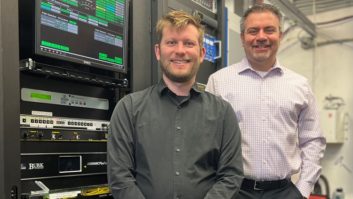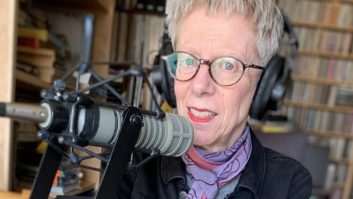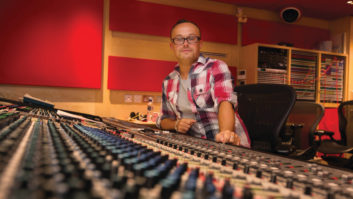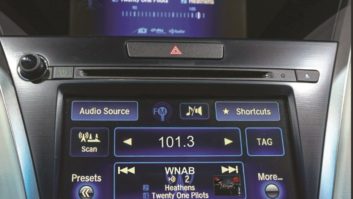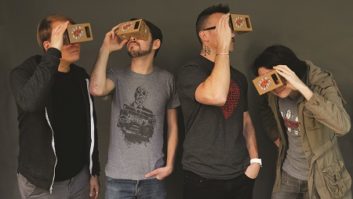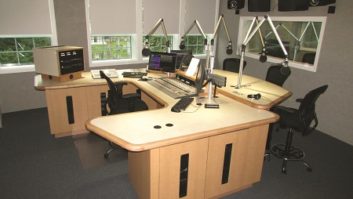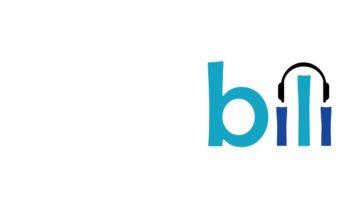There was a time, not too long ago, when the word “production” in the radio world had a fairly tight definition: radio program and commercial creation (often in-house). But as the radio industry has changed over the last decade, so has the meaning of production. New business pressures, new prospective revenue streams, new “content” ideas and changing expectations in management and clients have broadened the definition of “radio production.”
Radio World talked to a number of people and industry entities about their “production,” and we found many facets.

Pete Presnel hard at work in the studio with a new Wheatstone E-6 console and Blade 3 system.Pete Presnel is creative director for Crawford broadcasting’s Detroit cluster, WMUZ(FM), WEXL(AM) and WRDT(AM).
Radio World: Have you ever cut tape with a razor blade?
Presnel: Of course! That was one of only two ways to edit recordings (the other being building a composite of a track on a multitrack machine). Those of us of a certain age remember “rocking the reels” to find edit points, grease pencils to mark them, little short bits of tape hanging off the edge of a counter (trying to remember which piece had which bit on it), edit blocks, and having to carefully remove editing tape from the audio tape when the edit wasn’t exactly right.
RW: Are you/your department doing more production or less these days?
Presnel: Where we’re at, we are a production factory, especially commercials, but also imaging pieces for programming, promos and long-form programs. With modern digital tools, however, we’re able to be considerably more productive — editing of voice tracks, for example, is quicker, easier and more accurate by orders of magnitude. A single edit that can be accomplished in the space of a couple of mouse clicks today might have taken a minute or more back in the “old” analog days.
RW: What programs or elements are you providing more of?
Presnel: In our case, the bulk of our production is in the creation of commercials for our direct retail clients. And although our spot load had remained more or less constant over the years, working digitally means we’re able to have more time to, on the one hand, do more commercials, work on more complex productions, spend more time getting nuances of performance right, and so on. On the other hand, we have more time to spend on client service, developing strategies of campaigns, meaning we have the luxury of being able to have more time to think about campaigns, commercials and such so they have the best chance to do what are clients are paying us to do: Achieve a measurable result for the money they invest in us.
RW: What’s the biggest change in the production job over the last 5/10 years?
Presnel: Pretty obviously the productivity and creativity you get with digital production tools (we favor Adobe Audition here). There are things you can do with a piece of software you might pay a few hundred dollars for that runs on an off-the-shelf computer that simply could only be imagined in a room full of analog boxes that might have cost hundreds of thousands of dollars 20 years ago.

Andreas Sannemann of Benztown in his element.Andreas Sannemann, CEO and co-founder of international production house Benztown in Stuttgart, Germany, offered thoughts on dealing with multiple markets now that technology has made the world smaller and the international opportunities for work larger.
Andreas Sannemann: There are massive differences considering markets, countries, cultural background. For instance, German CHR listeners prefer a more musical, real, natural, maybe hip and relaxed approach … For Russia we do super-long, super-musical, mini-song-types of jingles up to 30 seconds (such as the package we did for Europa Plus Brigada U). This is compared to our U.S. operation where their clients are wanting everything short and quick due to PPM. The U.K. is very content-based, especially with the BBC formats — an example would be BBC 6 music. Australia has a massive density of huge talents working in the imaging sector.
One traditional source of production, outside the radio station, is the “jingle house.” TM Studios has long been known as a top-flight producer of jingles, station imaging packages, branding elements, music libraries and commercials. Technological advancement has opened a new door for them.

Making a living at TM Studios — (L–R) Collin Gouldin, producer; Dave Giangiulio, chief engineer; Ryan Drean, creative director; and Carly Reign, production director.Greg Clancy is GM/VP of creative at TM Studios, and Ryan Drean is creative director.
RW: TM Studios is famous for its jingles going all the way back to founder Tom Merriman. He’d get the singers around the mic and create the harmonic magic (with a little post-production help). While that’s often still done, how has technology expanded your toolkit?
Greg Clancy: With recent technology advancements, we have unlimited capacity to work from our Dallas headquarters with musicians in Nashville and New York or singers in L.A. and London … Our writers, producers and talent are trading charts and creating music as if they are all actually working together in our renowned Studio A, when in fact there might be 5,000 miles of geographic separation. So not only can we utilize talent around the world, but we can produce that talent live from anywhere, as well.
Ryan Drean: By utilizing technology like ipDTL and/or Source-Connect Now, there is effectively no barrier between us and worldwide talent. We Skype or [Google] Hangout with our talent face to face, and we no longer rely on archaic ISDN technology to record, as we now have that level of connectivity over the Internet … Couple all of that with the staggering advancements in simply transferring sizable data, we now have an instantaneous connection to our creative talent, our remote support staff and most importantly, our clients.
We asked a number of production managers and personnel: What’s the biggest trend or change that you are seeing these days? Dan Kelly is creative services director, WPLJ(FM) and Nash-FM, New York. Dan Stone is creative services director for Cumulus Chicago.

WPLJ’s Dan Kelly takes a quick break from his duties.Dan Kelly: Due to PPM, many stations tend to run a lot of elements over music. That’s been a major factor over the past few years, yet the purpose of imaging is still the same. Brand the station, relate to the audience and have fun. As always, writing is the most important thing. When your elements are playing over music, there’s little use of FX, so you really need to get your point across in words, and as few of them as possible to fit over intros. Hopefully we always spend lots of time writing fun, concise copy that connects with listeners!
Dan Stone: If I were to pick one thing it would be the release of Pro Tools 12 and Avid’s new subscription plan.
Ideally the subscription and lower cost of entry, which will cost you more over time, could act as an incubator/pipeline for younger, less established (read: broke) producers who have other less expensive options.
Cloud Collaboration and the Avid Marketplace in PT12 could be a game-changer. Beyond the ability to share and work on projects across different workstations, producers will have the option of selling, buying or sharing content within the DAW.

Westwood One News’ Bob Constantini uses a laptop computer in his remotes.A syndicated news service isn’t a new thing, even if the individual players might be new. It would also seem to be a programming format that doesn’t change much in its production and should be simple to produce. However, technological change has reoriented working practices and opened opportunities. Bart Tessler is EVP for news and talk, Westwood One:
RW: Syndicated news would seem to be a pretty straight-forward product. What could be new there?
Tessler: The trend is hypercustomization, localization, service; and Westwood One News was launched to meet these needs. After our research and discussion with program directors, we took a new approach by launching a non-branded network news product to allow affiliates to fully integrate into their local news and branding. Meeting this goal included development across a number of fronts, down to testing of a news sounder with various station imaging so that it would announce a network newscast but also integrate seamlessly. We provide 24/7 newscasts, special reports, and other network services but the station is the brand.
RW: Traditionally syndicated news segments were delivered on a regimented clock and either aired as an unedited whole or small clips would be cut out for use by a local anchor. However, news budgets have shrunk and local station news departments have disappeared in so many markets.
Tessler: A big part of developing Westwood One News was a focus on live, custom reports direct to stations. Westwood One News correspondents in D.C., N.Y., L.A. and Dallas do numerous daily reports and two-ways with affiliates. And with support from CNN, we have arranged many direct live appearances on local stations from reporters in places like Nepal, following the recent devastating earthquake; Havana, immediately after the announcement of a change in U.S. policy toward Cuba; and Tehran, after the signing of the preliminary U.S.-Iran nuclear agreement. We’ve also arranged CNN correspondent Q&As from Nigeria and Chad on Boko Haram and from Paris right after the Charlie Hebdo shootings.
Jeffrey Schwartz is the EVP of corporate strategy at Yahoo Sports Radio. While it has programs that need to be produced, much of its content is barebones sports talk punctuated with phone interviews and calls from listeners. New is its outside-the-box approach to the overall concept of programming — at one point making the studio part of the programming.
RW: Yahoo! Sports Radio has put an on-air studio into a restaurant at The Palazzo hotel and casino in Las Vegas. That is certainly not your typical location for a broadcast studio. What was the thinking behind that?

Yahoo! Sports Radio’s Ken Thompson, right, interviews Manny Pacquiao.Schwartz: Las Vegas is where our audience (mostly men) goes to play. Vegas is an ultimate destination for the sports fan — their home away from home. Placing a studio in Lagasse’s Stadium [a restaurant in the hotel] gives Yahoo Sports Radio greater opportunity to interact face-to-face with our listeners, as well as extend our valued partnership with the Palazzo Las Vegas, which includes on-air integration, a nightly show live from the stadium with Ken Thompson’s “Sports X Radio,” and our annual Super Week that brings together all of our hosts in one location for an entire week. It also opens doors to new opportunities and engagement events in the market, like becoming a key media partner for the first-ever National Fantasy Football Convention, presented by Dallas Cowboys quarterback Tony Romo.
RW: So the studio gets regular use. Is it a significant part of the YSR broadcast strategy?
Schwartz: We broadcast “Sports X Radio” from the studio nightly, Monday through Friday, and our afternoon drive program, “Prime Cut” with Sean Salisbury and John Granato enjoy going there whenever they can … We also try to be on-site for major sporting events like the Super Bowl and Final Four … It’s definitely a significant part of our strategy in advertising partnerships, access to listeners, fun giveaways, and our goal to have our 24-hour lineup of shows originating from a variety of major markets around the nation. We want to represent our listenership across the country.
RW: Traditionally, sports talk radio is a pair of guys in a studio yacking at each other and fielding calls. Taking the show on the road to sports events to do remote broadcasts used to be a special treat reserved for events like the Super Bowl but now shows seem to move more often and stay longer. What do you get out of these? Are you planning more of these?
Schwartz: Naturally, there is always financial consideration; don’t forget, at the end of the day, we need to make money to pay the bills. But, also, talent loves going different places to meet the people who make this fun opportunity of radio possible. We meet with affiliates, listeners, advertisers — it just changes things up a little. A change of pace once in a while is a good thing and benefits everyone, plus it keeps the programming exciting.
Share your own experiences. Write to[email protected]with “Radio Production” in the subject field.





